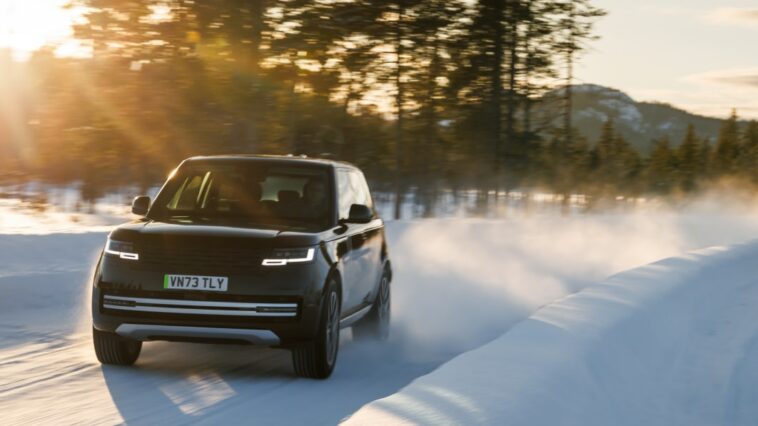Land Rover has put it (virtually) all on the market with the brand new Vary Rover Electrical prototype, camouflaging the car in nothing greater than a flat black paint job. The testers have begun their world torture testing, drifting the approaching Vary throughout Sweden’s frozen lakes in what we’ll guess is Arjeplog, one of many favored spots for testing car drifts and snow drifts at -40 levels Fahrenheit.
Our suspicions from the primary teasers seem confirmed, that the full-size flagship will not veer a lot from the ICE-powered variations with respect to seems to be. The minimalist design is all there, all the way down to the grille and decrease consumption. The higher portion is not a flat panel on the prototype, it is formed to appear to be the usual automotive’s. Beneath, the highlighted twin bars may very well be the EV’s main signature, the way it’s informed from its typical counterparts from a distance. The earlier teaser additionally revealed wheel middle caps inscribed with “EV.” Any of this may very well be tweaked for manufacturing, in fact.
The Automotive Information future product pipeline says to anticipate a dual-motor powertrain. All we find out about output is the promise of “V8 ranges of efficiency.” For the reason that battery-electric mannequin might be anticipated to weigh greater than the 5,985-pound, ICE-powered, SV trim, we’re in search of the electrical model’s output to match the sensation of the 523 horsepower and 553 pound-feet of torque the SV will get from its BMW-sourced, twin-turbo 4.0-liter V8. An 800-volt structure will guarantee fast refill instances for what’s sure to be a stout battery.
No matter that powertrain is, the automaker’s constructing it in-house — battery, electrical drive items, and software program — and assembling it within the plant that builds ICE-powered Ranges. This marks a change from the JLR Group’s solely different EV thus far, the Jaguar I-Tempo.
Land Rover says its designed software program to make traction management the accountability of every drive unit as an alternative of getting to speak with a central processor that employs ABS to regain traction. This could be the aim in each EV — most notably talked up by BMW for its coming electrical efficiency vehicles — due to the vastly faster response instances. Land Rover says torque response time drops from round 100 milliseconds with a processor and ABS to as little as one millisecond.
The debut is probably going penciled in for late this 12 months. After it launches, battery-powered variations of the Defender and Velar will comply with, most likely as a part of deliberate refreshes of Land Rover’s total lineup.


